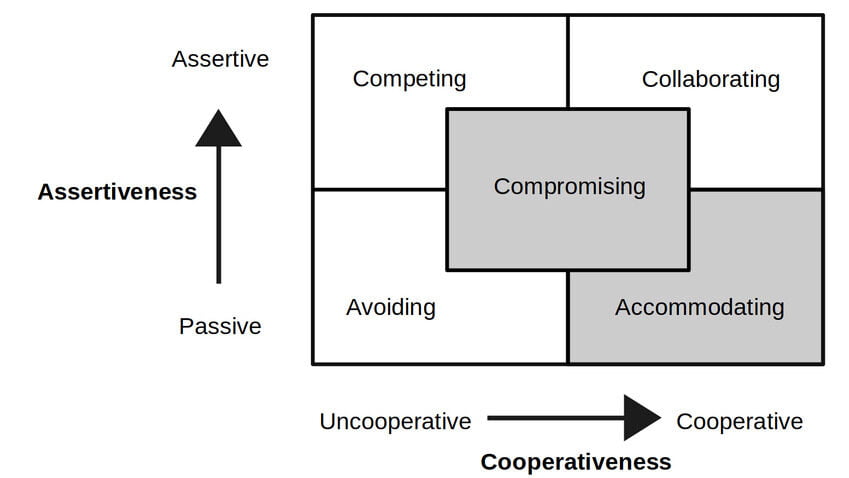
Workplace conflict is a common challenge that all organizations encounter. The way managers and supervisors handle workplace conflict can have a significant impact on productivity, morale, and employee retention.
Additional Resource
The Ultimate Guide to Training Your Supervisors and Managers
Learn how training your supervisors and managers will help them overcome challenges, motivate those around them, and be more effective in their roles.
This guide provides information on various conflict management styles, aiming to assist leaders and HR professionals in training their managers and supervisors with the essential skills to handle workplace disputes.
Understanding Conflict in the Workplace
Prior to exploring the various conflict styles, it is essential to understand the impact that conflict can have on an organization. Disagreements between employees or teams can have negative effects on productivity, morale, turnover, and even the risk of harassment or violence. Additionally, communication breakdowns between teams or individuals can impede progress, highlighting the importance of effective conflict management for managers and supervisors.
What Are Conflict Management Styles?
Put simply by Walden University, conflict management styles are the strategies individuals use to navigate a disruptive situation. These styles have their roots in the widely recognized Thomas-Kilmann model.
The Thomas-Kilmann Model
The Thomas-Kilmann model, developed by psychologists Kenneth Thomas and Ralph Kilmann in the 1970s, is a widely recognized framework for understanding individual responses to conflict situations.
The model outlines five primary conflict management styles based on two dimensions: assertiveness (the extent to which an individual attempts to satisfy their own concerns) and cooperativeness (the extent to which an individual attempts to satisfy the concerns of others).
These five styles are:
- Competing
- Accommodating
- Avoiding
- Compromising
- Collaborating
Each style is effective in specific situations, and understanding when to use each one can significantly enhance interpersonal interactions and conflict resolution outcomes.
5 Key Conflict Management Styles

1. Competing
The Competing style of conflict management is characterized by assertiveness and a desire to satisfy one’s own concerns at the potential expense of another’s needs. Individuals using this style prioritize their own goals and objectives, often seeking to “win” the argument or situation.
While the Competing style can be effective in situations where quick, decisive action is needed, such as when others’ safety is at risk or there is a known emergency, it may not always foster collaborative or positive interpersonal relationships.
Relying too heavily on this style may result in others feeling resentful or perceiving aggression, which could harm long-term relationships. When used correctly, it can help address valid concerns during critical moments of potential conflict.
Example: During a routine safety inspection in a manufacturing facility, a flaw is discovered in one of the production machines, posing immediate danger to workers. However, stopping the machine for repairs means not meeting a vital client deadline. The safety manager employs the Competing style, shutting down the machine for repairs to prioritize employee safety over the impending deadline despite the potential for client dissatisfaction.
2. Accommodating
The Accommodating style of conflict management is characterized by a high degree of cooperativeness, where an individual prioritizes the concerns and needs of others over their own. Those who lean towards this style often seek harmony and are willing to “give in” to maintain peace and avoid confrontation.
This approach can be particularly beneficial when recognizing that the other party has a better solution or when preserving the relationship is more valuable than winning the argument.
A constant or inappropriate use of the Accommodating style may result in one’s own needs being persistently overlooked, potentially leading to feelings of resentment or being taken advantage of. While it promotes harmony and preserves relationships, it’s important to ensure that accommodation doesn’t evolve into self-sacrifice to the detriment of personal or organizational goals.
Example: An experienced employee expresses serious reservations and discomfort regarding the adoption of a new technology platform due to a steep learning curve and tight project timelines. The project manager, utilizing the Accommodating style, decides to delay the implementation of the new technology, prioritizing the employee’s concerns and expertise, ensuring the employee remains engaged and the project can benefit from their skills and experience.
3. Avoiding
The Avoiding style of conflict management is marked by a deliberate choice to not address or confront a conflict directly. Instead, individuals using this style might sidestep, postpone, or simply withdraw from the conflict situation.
The Avoiding style can be a strategic choice when the issue at hand is trivial, when there’s no immediate solution, or when taking a pause provides time to gather more information or cool heightened emotions. However, consistently relying on avoidance can lead to unresolved issues festering beneath the surface, which might magnify problems in the long run.
While it can act as a temporary buffer against potential confrontations, overuse of the Avoiding style risks creating an environment where crucial matters are left unaddressed, potentially undermining trust and team cohesion.
Example: During a team meeting, a heated debate ensues between two team members about where to hold a company social gathering, and the debate starts to get personal. The team leader, using the Avoiding style, redirects the discussion to to work-related topics and sends each team member an email later, avoiding further confrontation and ensuring the meeting stays productive and on topic.
4. Compromising
The Compromising style of conflict management strikes a balance between assertiveness and cooperativeness. It involves both parties making concessions to reach a mutually acceptable solution, often viewed as a “middle ground” approach.
This style is particularly useful when a quick resolution is desired or when both sides hold equal power or importance in a situation, making it neither feasible nor productive for one side to dominate. By fostering an environment of give-and-take, the Compromising style can lead to faster resolutions and can be perceived as fair by all parties involved.
A potential downside is that the compromise might not fully address the root causes of the conflict or meet the deeper needs and concerns of the parties involved. While it may serve as a short-term solution, over-reliance on compromising might neglect underlying issues, leading to recurring conflicts in the future.
Example: Two departments within a company are attempting to use a limited capacity conference room during overlapping time slots, each presenting equally important and time-sensitive agendas. The department leaders utilize a Compromising style, agreeing to adjust their meeting schedules slightly to share the available time equally, thereby ensuring that both departments can conduct their meetings, albeit in shorter than ideal timeframes.
5. Collaborating
The Collaborating style of conflict management is characterized by both assertiveness and cooperativeness, aiming to address the concerns of all parties involved. This approach seeks to find a “win-win” solution, where the objective is not just to find a middle ground, but to arrive at a resolution that satisfies the needs and concerns of everyone.
Collaborating encourages open communication, deep listening, and creative problem-solving. It’s especially effective when the goal is to merge perspectives from diverse stakeholders or when the potential for synergy exists.
While the Collaborating style can lead to comprehensive and enduring solutions, it can also be time-consuming and may demand significant effort in terms of communication and understanding. It requires a high degree of trust, openness, and mutual respect, and may not be feasible in situations where a quick decision is needed or when parties are not willing to invest the time and effort required for genuine collaboration.
Example: Two customer support teams from different locations are encountering similar issues with a product and have developed separate solutions that only partially resolve the problems. Using a Collaborating style, the managers of both teams decide to facilitate a series of joint workshops where team members can share insights and combine their solutions, ultimately creating a more comprehensive resolution.
Implementing Conflict Management in the Workplace
- Training — Investing in Conflict Resolution Training is one of the best steps organizations can take. It offers structured guidance and tools to handle interpersonal conflict effectively.
- Emotional Intelligence — Leaders should encourage emotional intelligence amongst managers and supervisors. Recognizing and managing emotions can prevent many future conflicts. Emotional Intelligence training or employee assessments like DiSC can help employees and managers learn more about their personality styles and the impact those styles have on others.
- Open Dialogue — Encourage open communication channels. Regular team meetings or feedback sessions can offer a platform for airing grievances and finding a beneficial outcome.
Workplace conflict, when managed properly, can lead to growth, better understanding, and improved teamwork. By understanding the various conflict management styles and their applications, managers and supervisors can effectively navigate and resolve conflicts, ensuring a harmonious workplace environment.

